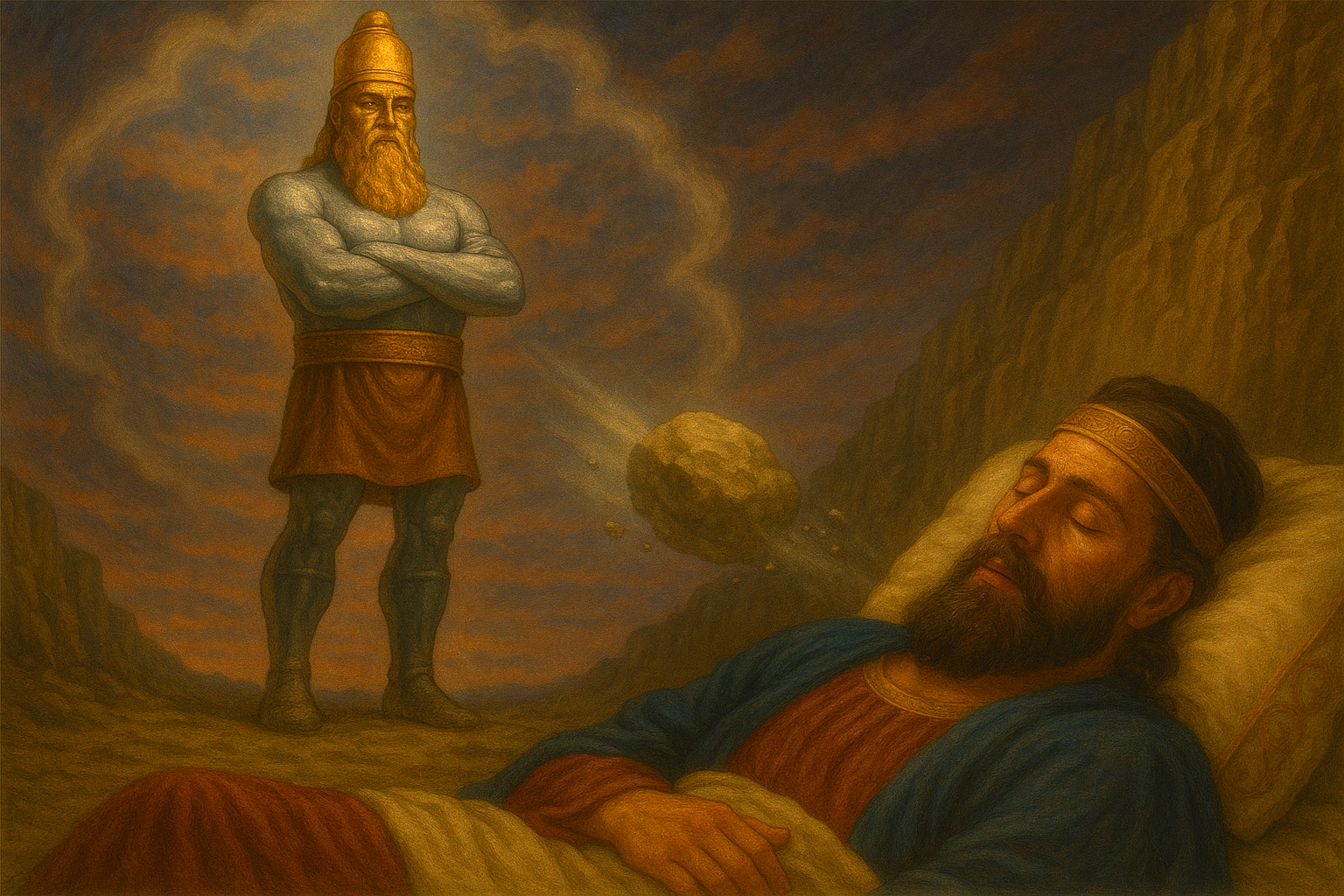Nebuchadnezzar's Dream
Daniel, like all other Old Testament writers, is ultimately looking forward to the New Covenant — the New Israel.

A Heavenly Kingdom
The prophecies of Daniel are among the most remarkable ever made. Not only are they astoundingly detailed and accurate, but they also look forward to the most important event in Christian history — the coming of Christ’s kingdom.
Many Christians are fascinated by these prophecies, yet they are often confused by the many conflicting interpretations offered. Jesus Himself sometimes deliberately veiled His message in parables — as explained in Matthew 13:10–17. In a similar way, the prophecies in Daniel were sealed by God:
“But you, Daniel, shut up the words, and seal the book until the time of the end;” (Daniel 12:4).
To truly understand Scripture, we must at times approach it through a Hebrew lens. Daniel’s prophecies come to us from the East, and are shaped by a worldview that is often poetic, symbolic, and rooted in narrative — rather than the analytical, chronological, scientific logic of the modern West.
Daniel, like all other Old Testament writers, is ultimately looking forward to the New Covenant — the New Israel. When Christ came, He taught that He was the Messiah, and that the New Israel, is not an earthly kingdom, but a heavenly kingdom whose citizens are drawn from all nations.
Daniel’s Prophecy of Five Kingdoms
In the second chapter of the Book of Daniel, the king of Babylon, Nebuchadnezzar, has a troubling dream. Daniel, a young Jewish exile in Babylon, is asked to interpret it. The dream describes a large statue made of various metals, followed by a stone that destroys the statue and becomes a great mountain. According to Daniel, the dream outlines a sequence of world empires and the arrival of a new kind of kingdom.
The Dream of the Statue
The dream is recorded as follows:
“The head of this statue was of fine gold, its chest and arms of silver, its belly and thighs of bronze, its legs of iron, its feet partly of iron and partly of clay.”
—Daniel 2:32–33
Later in the vision, a stone strikes the statue on its feet, destroying it:
“As you looked, a stone was cut out by no human hand, and it smote the image on its feet of iron and clay and broke them in pieces... But the stone that struck the image became a great mountain and filled the whole earth.”
—Daniel 2:34–35
Daniel explains that each section of the statue represents a kingdom that would arise in history, one after another.
1. Head of Gold — Babylon
Daniel tells the king of Babylon:
“You, O king... are the head of gold.”
—Daniel 2:37–38
Babylon was a wealthy and advanced civilization in the 6th century B.C. It made significant contributions to astronomy, mathematics, and timekeeping — including the division of hours into 60 minutes and minutes into 60 seconds. Its capital city was famous for architecture, including the Hanging Gardens, one of the ancient wonders of the world.
2. Chest and Arms of Silver — Media
The second kingdom is described as “inferior” to Babylon:
“After you shall arise another kingdom inferior to you...”
—Daniel 2:39a
This refers to the Median Empire, which grew in strength as Babylon weakened, but it did not last long and left behind few cultural achievements.
3. Belly and Thighs of Bronze — Persia
“...and yet a third kingdom of bronze, which shall rule over all the earth.”
—Daniel 2:39b
The comparatively insignificant Median Empire was soon absorbed and eclipsed by the enormous Persian Empire, which emerged only shortly after Media had surpassed Babylon. It replaced the Median Empire and was by far the largest empire the world had ever seen, spanning from India to Egypt. The references to Cyrus, the Persian Emperor, in Isaiah and elsewhere indicate that the Persian Empire was far from “inferior.”
4. Legs of Iron and Feet of Iron and Clay — Greece
“And there shall be a fourth kingdom, strong as iron, because iron breaks to pieces and shatters all things; and like iron which crushes, it shall break and crush all these. And as you saw the feet and toes partly of potter’s clay and partly of iron, it shall be a divided kingdom; but some of the firmness of iron shall be in it, just as you saw iron mixed with the miry clay. And as the toes of the feet were partly iron and partly clay, so the kingdom shall be partly strong and partly brittle. As you saw the iron mixed with miry clay, so they will mix with one another in marriage, but they will not hold together, just as iron does not mix with clay.”
(Daniel 2:40–43)
This is a perfect description of the Macedonian Greek Empire. The legs of iron represent the empire under Alexander the Great, whose power was irresistible and phenomenal. He rapidly and completely shattered the Persian Empire.
Alexander may well have been the greatest military genius the world has known. Supreme in strategy, tactics, and organization, he was swift to strike, and he never knew defeat. From 334 B.C., his disciplined troops swept through the East with unprecedented speed and effectiveness.
But in 323 B.C., at the age of 33, Alexander died prematurely. The empire was then divided among his generals, resulting in internal division and weakness. The feet of iron and clay represent this post-Alexandrian period.
Alexander had initiated a plan to unite East and West under one Hellenic culture through intermarriage and the founding of numerous Greek colonies. These were intended as hubs of Greek life within non-Greek environments. Yet the intended fusion never occurred—“they will not hold together, just as iron does not mix with clay.”
Thus, the post-Alexandrian Greek Empire perfectly fulfills all aspects of the prophecy: division, partial strength, internal conflict, and unsuccessful intermarriage. The empire under Alexander—the legs of iron—was strong, while the divided successor states—the feet of iron and clay—were brittle and fragmented.
Rome?
Some interpretations identify the fourth kingdom as the Roman Empire. Christian Zionists even go so far as to suggest that it is a future, reconstituted, Roman Empire. However, the Roman Empire expanded gradually after Jesus was crucified and experienced many military defeats. It also remained unified for centuries, unlike the Greek Empire.
Lord Montgomery writes about the Roman army:
“The great weakness of Roman armies was lack of cavalry... For this reason the Romans could never have been a match for the Macedonian armies of the fourth century.”
—B. L. Montgomery, A History of Warfare
The Greek Empire’s last independent state, Egypt under the Ptolemies, ended in 27 B.C. Greek political and economic power disappeared when Egypt was annexed by Rome, but Greek soft power — its language, philosophy, and culture — continued to influence the region. The Roman Empire did not begin to break up until long after the stone had destroyed the Greek Empire. Jesus argued against the Hellenized practices of the Jewish religious leaders and his ministry was recorded in Greek — clear evidence that the stone struck the image at the end of the Greek Empire.
The Stone and the Fifth Kingdom
After the four empires, Daniel describes a stone that destroys the statue:
“A stone was cut out by no human hand, and it smote the image on its feet... and the wind carried them away, so that not a trace of them could be found.”
—Daniel 2:34–35
Daniel interprets this as the arrival of a new kingdom:
“In the days of those kings the God of heaven will set up a kingdom which shall never be destroyed... it shall break in pieces all these kingdoms and bring them to an end, and it shall stand forever.”
—Daniel 2:44
Jesus’ whole teaching was saturated with the claim that He was the Messiah. The following is an example:
‘The woman said to him, “I know that Messiah is coming (he who is called Christ); when he comes, he will show us all things.” Jesus said to her, “I who speak to you am he.”’ (John 4:25, 26)
Again and again Jesus showed how He was fulfilling all the Messianic prophecies. He referred to the Book of Daniel several times to speak about Himself. For example, in Matthew 24:15, Jesus warned His followers to watch for “the abomination of desolation spoken of by the prophet Daniel.” He told them to understand what Daniel had written. Also, when Jesus was on trial before the Jewish leaders, He called Himself “the Son of Man” (Matthew 26:64; Mark 14:62). This title comes from Daniel, where someone like a human being (“a son of man”) receives authority from God. By using this title, Jesus was showing that He is the one Daniel saw in his vision.
Jesus made it clear that Daniel's prophecy based on the image in Nebuchadnezzar's dream was fulfilled in every detail at the end of the Greek Empire when he spoke of himself being the stone mentioned in Daniel:
“The very stone which the builders rejected has become the head of the corner ... when it falls on anyone, it will crush him.”
(Luke 20:17–18)
References to Jesus as the Stone
The following table integrates literal stones with symbolic stone references to provide a comprehensive view of how Scripture points to Christ as the stone. Stones like Jacob’s pillar, the wilderness rock, and Daniel’s smiting stone foreshadow Christ’s role as provider, judge, and eternal king. Jesus is explicitly called the cornerstone, spiritual rock, and resurrected conqueror, fulfilling Old Testament prophecies.
| Chronological Order | Reference | Title/Description | Significance |
|---|---|---|---|
| 1 | Genesis 28:18 | Jacob’s Stone at Bethel | Memorial stone prefiguring Christ as the meeting place between heaven and earth. |
| 2 | Genesis 49:24 | Stone of Israel | Early typology of Jesus as the "Stone of Israel," emphasizing His strength and shepherd role. |
| 3 | Exodus 17:6, Numbers 20:11 | Rock Struck for Water | Prefigures Christ as the source of living water (1 Corinthians 10:4). |
| 4 | Joshua 4:7 | Twelve Memorial Stones | Symbolizes God’s faithfulness, fulfilled in Christ as the ultimate covenant memorial. |
| 5 | Psalm 118:22 | Head Stone of the Corner (Cornerstone) | The stone rejected by builders becomes the chief cornerstone—Jesus as the foundation. |
| 6 | Isaiah 8:14–15 | Stone of Stumbling | Jesus as a sanctuary and a stone that causes some to stumble and fall, highlighting division. |
| 7 | Isaiah 28:16 | Chief Cornerstone | Prophesies a precious cornerstone laid in Zion, fulfilled in Jesus as the foundation of faith. |
| 8 | Daniel 2:34–35, 44–45 | Smiting/Crushing Stone | The stone that destroys earthly kingdoms, symbolizing Christ’s eternal kingdom. |
| 9 | Zechariah 4:7 | Headstone of the Corner | The capstone brought forth with shouts of “Grace!”—applied to Christ’s exaltation. |
| 10 | Matthew 7:24–25 | Rock Foundation | Wise builder on the rock: Jesus as the unshakable foundation of faith. |
| 11 | Matthew 16:18 | Peter’s Confession (“Rock”) | Jesus builds His Church on the confession of faith in Him as Messiah. |
| 12 | Matthew 21:42, Mark 12:10, Luke 20:17 | Stone the Builders Rejected | Jesus identifies Himself as the rejected stone who becomes the cornerstone. |
| 13 | Matthew 21:44 | Grinding/Crushing Stone | Jesus as the stone that breaks or crushes those who oppose Him, emphasizing judgment. |
| 14 | Matthew 27:51, 60, 28:2 | Tomb Stone | Stone rolled away at resurrection: Jesus conquers death and removes barriers. |
| 15 | Mark 13:2 | Temple Stones Thrown Down | Signifies the end of the old covenant and the new order in Christ. |
| 16 | Acts 4:11 | Chief Cornerstone | Apostles declare Jesus as the cornerstone rejected by religious leaders. |
| 17 | Romans 9:32–33 | Stumbling Stone | Jesus as the stone that causes stumbling for those who reject Him. |
| 18 | 1 Corinthians 10:4 | Spiritual Rock | Christ as the Rock providing living water to His people. |
| 19 | Ephesians 2:20 | Chief Cornerstone | Jesus as the cornerstone of the Church’s foundation. |
| 20 | 1 Peter 2:6–8 | Chief Cornerstone, Stone of Stumbling | Jesus as both the cornerstone and a stone that causes unbelievers to stumble. |

